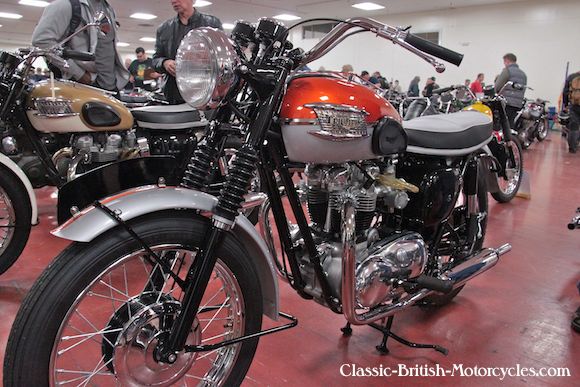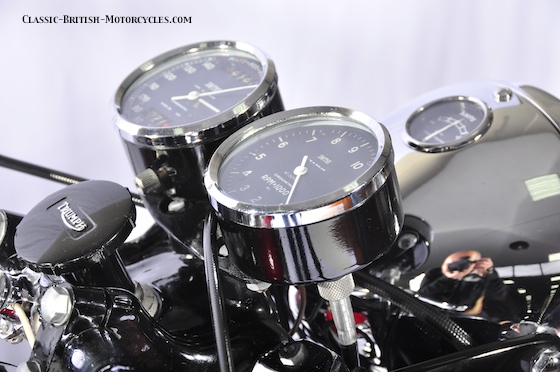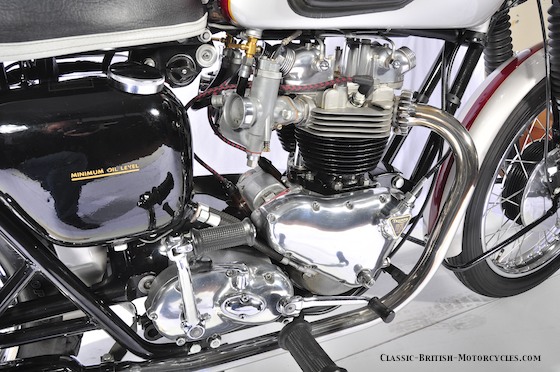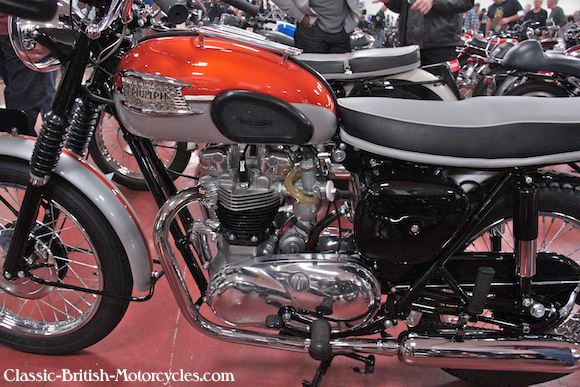1962 TRIUMPH BONNEVILLE -MODEL DESIGNATIONS
The 1962 Triumph Bonneville again came in two basic model designations: T120R was the Road version, and T120C was the Street Scrambler/Off-Road version (what later might have been called an Enduro). Most of the bike was strictly carry-over from 1961. Of course, this was the last year for the non-unit construction engine and the duplex frame, the same applied to its sister-bike, the Triumph TR6. So, Triumph Motorcycles did little development work to this ‘lame duck’ model. All the money, time and engineering was being poured into the new-for-1963 Unit-Construction 650.

TRYING TO ACHIEVE BALANCE
For the 1962 model year, most of the development work was aimed at quelling vibration, which with the added power of the twin-carb Bonnie, was beginning to be a real problem. Starting with Engine #K15789, the crankshaft balance factor was juggled again, from 50% back up to 71% (it had been dropped from 70% to 50% in 1959 in an effort to curb vibration). Then, starting with Engine #D17043, the balance factor was changed again to 85%, and an entirely new crankshaft was introduced, with ‘pear-shaped’ webs. The new crank was heavier, and while it may have helped reduce vibration slightly, it was at the cost of acceleration.

ABOVE: The Bonneville’s engine & gearbox from the timing side. Notice the open carbs (no filters) & the woven spark plug wires leading to either side of the magneto.
FUEL SYSTEM
While the carburetors remained the same, a new petcock arrangement allowed both carbs to be fed by either petcock. As it turned out, to capture the full performance of the 1962 Triumph Bonneville 650 engine, both petcocks still needed to be open to supply enough fuel to both carbs on full boil. The only other change to the powerplant was a slightly higher 3rd gear ratio.
THE SAME, BUT DIFFERENT
Again, as always, the 1962 Triumph Bonneville was the twin-carb version of the Triumph TR6, albeit with different paint colors.
ELECTRICS
The American-market T120Cs got a more waterproof “Wader’ version of the Lucas K2FC auto-advance magneto. A new Lucas RM19 alternator also made its debut, while retaining the previous lower-output stator to minimize bulb failure and battery overcharging. The horn was also changed to a Type H8.

ABOVE: Gauge cluster (clocks) on a 1962 Triumph Bonneville T120.
NEW COLORS
The biggest differences between the 1962 Triumph Bonneville and the 1961 it replaced (aside from the vibration-abatement measures), was the appearance of the motorcycle. The seat was now 2-tone, with a gray panel on the top surface and along the bottom edge, with black on the sides and back. And the color was a big switch from the pale blues of the past couple of years. For 1962, all Triumph Bonnevilles were painted Flame and Sliver Sheen. Flame, which is very orange, was on the top and Silver on the bottom, separated as before by a gold pinstripe.
LAST OF THE PRE-UNITS
The 1962 Triumph Bonneville marked the end of an age. It was the last non-unit construction motorcycle built by Triumph. Unit construction ushered in the modern age, or so it must have seemed at the time. Little did they know that just a few short years from then, the Japanese would flood the market with technologically advanced machinery the likes of which the world had never seen!


1962 Triumph Bonneville SPECIFICATONS
|
Bonneville T120/R Bonneville T120/C Engine type Displacement Bore & Stroke Compression Carburetor Ignition Engine output Primary drive Primary sprockets Clutch Gearbox 1st, bottom 2nd 3rd 4th, top Final drive Final drive sprockets Frame Type Suspension, front Suspension, rear Brake, front Brake, rear Tire, front Tire, rear Fuel Capacity Wheelbase Seat Height Ground Clearance Fuel capacity Dry weight |
Roadster (low pipes) Scrambler (high pipes) Air-cooled OHV vertical twin, non-unit 649cc / 40.0 ci 71mm X 82mm / 2.79″ X 3.23″ 8.5:1 2- Amal Monobloc 1-1/6″ Lucas magneto 46 bhp @ 6500 rpm 1/2″ X .335″ X 5/16″ chain, 70 links 22T X 43T Multi-plate, wet 4-speed constant mesh, right foot shift 11.9:1 8.25:1 5.81:1 4.88:1 5/8″ X .400″ X 3/8″ chain, 101 links 18T X 43T Brazed lug, rigid Telescopic fork, hydraulic damping Swing arm, 2 Girling dampers 8″ SLS drum 7″ SLS drum 3.25″ X 18″ Dunlop 4.00″ X 18″ Dunlop 3 Imp gal (US); 4 Imp gal (UK & export) 54.5″ / 140 cm 30.5″ / 77 cm 5″ / 12.7 cm 3 Imp gal (US); 4 Imp gal (UK & export) 393 lbs / 178 kg |



